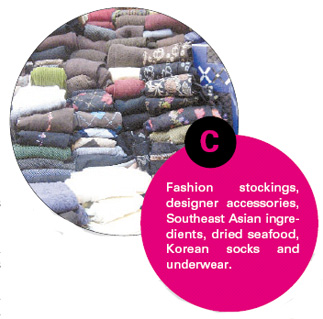Goblin markets stock everything, but goblins

The goblin market.
You can find one in the large underground black market wedged between the exit of Chung-ja Arcade and Namdaemun’s food alley.
If you walk out of Hoehyeon Station (line No. 4, exit 5) on Toegyero Street in central Seoul, you’ll find it.
There’s no proper name for this area, not even on the market’s map.
Over the years, merchants came to describe it as “an underground goblin market.”
The name is thought derived from the notion that the imported goods on sale are so various and curious, goblins must have fetched them from some mysterious place.

But the market has grown so big that it’s now virtually one of the city’s treasures.
Historically, the goblin market reflects Korea’s hybrid past. Shortly after the war, imported goods filled the markets. When asked what they sold, the hawkers would reply, “Everything except tanks.”
You can find cheese, chocolate bars, coffee mix and various condiments next to shops selling Japanese snacks, brand-name perfumes, designer accessories, fashion stockings, luxury kitchenware and miscellaneous local goods.
Everything comes at wholesale prices. Just don’t ask where it came from.
The items at a goblin market are also a nostalgic trip to 1980s America.
You can find Spam, Dial soap, Mennen Skin Bracer (men’s aftershave) and Airspum, an old-style cosmetic powder for women still popular among the market’s clientele.
A couple of other shops sell imported goods in Namdaemun.
The underground level of the Seungnyemun Complex of Imported Goods near the market’s main gate has been selling cameras and camcorders for over 30 years.
The goblin market, however, is the biggest and has the most variety.
Of five main buildings in the center of the market, marked in alphabetical order from C to G, the underground floors of buildings C, D and E house goblin black markets.
The rest sell locally made clothes, socks and children’s clothes.
Each building specializes. Section D stocks imported food, mainly American and Japanese, but Southeast Asian ingredients and snacks are also available.
Typical items include canned food, dried cheese, frozen fishcakes and sweets.
In the area’s far corner, merchants sell antique furniture.
Section C is a jumble of miscellaneous goods, including cosmetics and cigarettes, local and imported; E sells kitchenware.
One of the most underestimated yet most dynamic parts of the goblin market are the tunnels that connect the buildings.
They are a whole world of their own.
Between C and D is an old seafood market.
An aisle connecting D and E is the busiest section, mainly selling health food and imported steak and oxtail.
This is also a place to find mounds of imported fruit like fresh mangos. A couple of delis sell fresh cheese at wholesale rates.
Just under the stairs in the same alley, there’s a small noodle vendor called Imone Guksujip, or Auntie’s Noodle House.
It’s famous for a humble noodle soup, which costs 3,000 won ($3.17) a bowl.
Most shops are open from noon through the evening. To get to the goblin market, take exit 5 at Hoehyeon Station, line No. 4. Walk straight until you hit Chung-ja Arcade. Credit cards are accepted, but most shops ask for cash when you’re trying to haggle down prices, which is recommended. For more information, call the market’s tourist office at (02) 752-1913.
By Park Soo-mee Staff Reporter [myfeast@joongang.co.kr]










with the Korea JoongAng Daily
To write comments, please log in to one of the accounts.
Standards Board Policy (0/250자)